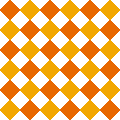|
Cichlidae posted:There's a lot to be said for free intersections on low-volume, low-speed roads. Even putting up a pair of yield signs is better than stop signs in most neighborhoods. The neighborhood association finally got the city to come in and put in stop signs about a year ago. Much nicer now.
|
|
|
|

|
| # ? May 11, 2024 23:16 |
|
Choadmaster posted:This reminds me of something, and if I remember correctly you worked in France for a bit so hopefully you can confirm this for me: The general rule is Priorité ŕ Droite, which means a car on the right has the right-of-way. However, most arterials and primary routes have diamond-shaped yellow-and-white signs that show that you're on a prioritary road, and don't have to yield. These signs are at every single intersection. There are also signs which say you have / don't have the right-of-way, for individual situations where it'd be impractical to designate a prioritary route. grover posted:Wouldn't be so bad if you could see if there was anyone coming, but between the trees, houses and weeds, visibility is nil. I've nearly been in an accident SO many times... That's where yield signs come in. If you can't see around the corner, you need to slow down. If you can, you're good to roll through if the way is clear. And if intersection sight distance is so low, the homeowners on the corners should clear out any vegetation or other sight blockers in the area to improve it.
|
|
|
|
Choadmaster posted:I find it very hard to believe this could work but he swears it's true and it works fine. I use some of those smaller roads on my commute (there's no alternative) and now that it's summer and there's crops in the fields, I have to slow down to 30-40 km/h on an 80 km/h road at a few intersections, because there could be something coming from the right and you can't see a thing because there's a corn field in the way. Lately it also seems fashionable for municipalities to turn their main roads through villages (or secondary roads in larger towns) into 30 km/h areas with free intersections for every side road (which are pretty frequent) to make it safer for cyclists and pedestrians. Other traffic or parked cars serve as the traffic calming in this case, and there are (almost) no signs. It's nice if you live there, not so nice if you have to pass through there and there's no other main road to take. I almost never see stop signs, except when a small road intersects a main road and there's no good view of oncoming traffic, or it's a busy and high-speed main road. edit: We also have the diamond signs for priority roads and other things Cichlidae described. Entropist fucked around with this message at 13:12 on Aug 11, 2010 |
|
|
|
Cichlidae posted:That's where yield signs come in. If you can't see around the corner, you need to slow down. If you can, you're good to roll through if the way is clear. And if intersection sight distance is so low, the homeowners on the corners should clear out any vegetation or other sight blockers in the area to improve it.  They've since changed the signage so that this road is the primary road, and the two cross roads have stop signs.
|
|
|
|
What's the deal with the "pointless" traffic lights you see sometimes? Just a screw-up that no one noticed until the project was done? This one is on an off-ramp from Rt. 8. The only road that would see this light is a one-way going the other way. And it's right next to a DO NOT ENTER sign. I kind of thought that traffic lights were expensive, so it's weird to have extras that don't really do anything.  
|
|
|
|
Cichlidae posted:Yeah, that's what I figured for the queue. As to how drivers perform in roundabouts here, Americans are 10-15% less efficient at driving, so I'd just bump the volumes up by 10%. Funny thing, we use 0.85 volume/capacity as the breakpoint here, not 0.8 like you do. Well, the 0,85 saturation degree and the 10% increase in input might just cancel eachother out. Play with it for a while and see what works On a completly unrelated note, you wouldn't have any internships for international students available, or would you?
|
|
|
|
Cichlidae posted:That'll depend on your school, then. The one I went to required calculus 1-4, and calc 4 (diffeqs) was a "no calculators" class. You could possibly get into traffic engineering without an engineering degree, but you would need prior experience in the field. Maybe begin with an internship? I'll be starting at George Mason University at the end of the month. I already bombed the math placement test twice so I'll be in the math class that doesn't require that you even take the test, let alone pass it. (My scores were around 40, don't remember what they were precisely, passing, 70)
|
|
|
smackfu posted:What's the deal with the "pointless" traffic lights you see sometimes? Just a screw-up that no one noticed until the project was done?
|
|
|
|
|
smackfu posted:What's the deal with the "pointless" traffic lights you see sometimes? Just a screw-up that no one noticed until the project was done? That one (like most pedestal-mounted signals) is for pedestrians. We use the vehicular heads sometimes for concurrent ped phases, though there have been lawsuits in other states that may eventually force us to go to actual pedestrian heads and dedicated ped phases. Dutch Engineer posted:Well, the 0,85 saturation degree and the 10% increase in input might just cancel eachother out. Play with it for a while and see what works We unfortunately have had a hiring freeze for the last 2 years, which hurts long-term job prospects, but we do have a decent number of intern positions. It can't hurt to apply, though there is very tough competition at the moment due to all of the engineering grads who can't get jobs. Try contacting someone. Worth a shot, right?
|
|
|
|
Dutch Engineer posted:On a completly unrelated note, you wouldn't have any internships for international students available, or would you? No! Don't let him come here and build roundabouts!
|
|
|
|
grover posted:It's not the intersection itself, but the approach. There's no visibility as you approach, forcing all drivers to either stop/rolling stop or a gas it on a suicide gamble. Tearing down houses and clearcutting the lot aren't really viable. Local law here is that a no-way stop like this is actually supposed to be treated as a 4-way stop, but I seemed to be the only one who ever stopped. You might be the crazy one for stopping. The only Virginia codes I found on uncontrolled intersections says you just need to yield the right of way to the car on the right, or yield to the non-terminating road of a T-intersection. I couldn't find a code for blind intersections. In California, we have a code that says if you are within 100 feet of a blind intersection and can't see 100 feet down every other leg of the intersection, the speed limit is 15 MPH.
|
|
|
|
Phanatic posted:There are so damned many intersections where one flow of traffic should just have right-of-way and intersecting traffic should get a yield sign, it's ridiculous. There's one neighborhood in my area I have to visit every now and then which has yield signs everywhere you'd usually expect to see a stop sign. I think it's awesome and that every residential neighborhood should be that way. If two low speed low volume roads intersect and there's plenty of visibility, there's no reason I should have to stop if there isn't traffic.
|
|
|
|
theflyingexecutive posted:No! Don't let him come here and build roundabouts! gently caress that, come here and replace this clusterfuck where AZ79 and AZ287 intersect with a couple of roundabouts:  You have to zoom in further but if you look at the blob on the west side near the Burger King, it's a smaller scale of the setup between 287 and 79.
|
|
|
|
wolrah posted:There's one neighborhood in my area I have to visit every now and then which has yield signs everywhere you'd usually expect to see a stop sign. I think it's awesome and that every residential neighborhood should be that way. If two low speed low volume roads intersect and there's plenty of visibility, there's no reason I should have to stop if there isn't traffic. They're even used in flat areas at the intersection of two high-speed rural roads. I'm not sure about safety, but the delay is certainly much lower than an all-way stop. IOwnCalculus posted:gently caress that, come here and replace this clusterfuck where AZ79 and AZ287 intersect with a couple of roundabouts: The volumes are probably pretty low there, since it's a small town, so roundabouts could be a great choice.
|
|
|
|
Dutch Engineer posted:Well, the 0,85 saturation degree and the 10% increase in input might just cancel eachother out. Play with it for a while and see what works Hey come on over and play @ wegenforum.nl or the highways and autobahn-section on skyscrapercity.com 
|
|
|
|
So a road near me got resurfaced and painted. Before the road had 2 lanes in each direction. Now, it has 2 northbound and 1 southbound and one turn lane. That struck me as strange that the capacity for each direction wasn't the same.
|
|
|
|
Guy Axlerod posted:So a road near me got resurfaced and painted. Before the road had 2 lanes in each direction. Now, it has 2 northbound and 1 southbound and one turn lane. That struck me as strange that the capacity for each direction wasn't the same. Volumes aren't always the same in each direction. Some of our roads are 1-2, and the volumes match, more or less. In your case, even if the volumes are equal, the safety benefit of taking turning vehicles out of the through lanes probably outweighs the detriment to capacity. In rural areas, high speeds mean that vehicles stopped in a through lane are fatal rear-end accidents waiting to happen. In urban areas, the frequent driveways and side streets mean that the through lane is often blocked by turning vehicles and loses most of its capacity.
|
|
|
|
Hey Chiclidae, How much do you know about Route 202 in New Hartford? My uncle and his friend were in a very bad accident there over the weekend. A woman went into the wrong lane in a double yellow and hit them head on. Is this a common thing that goes on in that part?
|
|
|
|
What's up the yield sign on the right side? click me Doesn't the stop light take priority? Why even have the sign?
|
|
|
|
ijustam posted:What's up the yield sign on the right side?
|
|
|
|
ijustam posted:What's up the yield sign on the right side? Man its Muncie. I used to walk across this every day
|
|
|
|
kefkafloyd posted:Hey Chiclidae, New Hartford's not my district, so I can't say much. Even if I did know, unfortunately, it wouldn't be ethical for me to disclose specific safety information. Sorry, you know how lawyers can be... "See? This engineer even admitted that the intersection is accident-prone! The state knew about it and didn't do anything!" ijustam posted:What's up the yield sign on the right side? The MUTCD says pretty clearly that you mustn't use stop or yield signs at a signal. Conflicting messages and all that. If there's a problem with accidents on right turns, posting NTOR would be much better than a yield sign.
|
|
|
|
Shavnir posted:Man its Muncie. I used to walk across this every day Man that's only one of three five-points in Muncie Edit: By the way Shav, they decided to totally repave Tillotson. There's your going-away present. 
ijustam fucked around with this message at 04:35 on Aug 18, 2010 |
|
|
|
ijustam posted:What's up the yield sign on the right side?
|
|
|
|
holy poo poo this: http://xkcd.com/781/
|
|
|
|
Captain Corny posted:In the Netherlands most intersections with stop lights have yield signs as well. It's for when the lights break or are turned off late at night. The lights have priority during normal operation. Our lights here flash when they're not in sequential operation. Flashing yellow means you have the right of way (unless you're turning), and flashing red acts like a stop sign. The only times I've seen signs and signals at the same time are: - When the signal is brand new and being turned on. It takes a few minutes to remove the stop signs, but the signal is flashing red at this point so there's really no conflict. - When it's a signal that's infrequently used, for example, at a parking lot that's very busy once a year for a fair. The stop signs in this case have a hinge in the middle and can be folded up or down depending on whether they're needed. ijustam posted:holy poo poo this: http://xkcd.com/781/ Reading direction is still under debate among the community. When you're tailgating someone and can only read one line at a time, forcibly you'll read the closest line first. Many of the messages we use, like "BUS ONLY," are comprehensible no matter how they're read. The bigger problem comes when you're putting words on signs. Let's say you're in this situation: you're on a main street, approaching three intersections, with 1st Street, 2nd Street, and 3rd Street. There's an advance guide sign to tell motorists which streets they're approaching. Which one do you do? code:code:
|
|
|
|
Cichlidae posted:Our lights here flash when they're not in sequential operation. Flashing yellow means you have the right of way (unless you're turning), and flashing red acts like a stop sign. The only times I've seen signs and signals at the same time are:
|
|
|
|
Cichlidae posted:Reading direction is still under debate among the community. When you're tailgating someone and can only read one line at a time, forcibly you'll read the closest line first. Many of the messages we use, like "BUS ONLY," are comprehensible no matter how they're read. I know you just said there's no agreement, but I'm going to voice my opinion and see if anyone else will argue the reverse. If the sign is forming a map or graphic of the roadway in some form, then the text should be aligned with the graphic so that the visual and textual cues agree - this is obvious. But if the sign is simply text, as your example shows, then the nearest (i.e. most important) intersection should be at the top, where someone unfamiliar with the intersection would read first. We are trained in everything we read that you start at the top-left, so without prior knowledge of the sign's arrangement that is what will be read first. And in this case, such decisions should be specifically targeted at drivers who are unfamiliar with the region, as they are the most likely to need the information on the sign; local drivers will adapt to whatever convention the signs use. I could see that if every directional sign were presented in reverse order (within a large region like a state), it might work, simply because drivers would look at the bottom first when driving in that region. It would need to be universal within that region, or people will spend even more time reading each sign, as they read both the top and bottom lines to figure out what is coming next. I have a hard time seeing any state willing to spend the money to switch all the signs around at once, for what seems to be a pretty minor benefit (at most). That said, I still chuckle every time I notice that I'm using the "lane bike" to get home. I don't know why, it's not even funny.
|
|
|
|
Cichlidae posted:New Hartford's not my district, so I can't say much. Even if I did know, unfortunately, it wouldn't be ethical for me to disclose specific safety information. Sorry, you know how lawyers can be... "See? This engineer even admitted that the intersection is accident-prone! The state knew about it and didn't do anything!" This is true. Don't mean to put you in a bad spot and all.
|
|
|
|
Cichlidae posted:Our lights here flash when they're not in sequential operation. Flashing yellow means you have the right of way (unless you're turning), and flashing red acts like a stop sign. The only times I've seen signs and signals at the same time are:
|
|
|
|
Cichlidae posted:- When it's a signal that's infrequently used, for example, at a parking lot that's very busy once a year for a fair. The stop signs in this case have a hinge in the middle and can be folded up or down depending on whether they're needed. Those folding stop signs can be found on every signal in Illinois, and are used when the signal is out. I don't know why other states don't do this, it clears up confusion (even though everyone should know what to do at a broken signal).
|
|
|
|
The scary thing is at night when people basically don't even see a stoplight that's completely out. That's where you really need the stop signs, although it can take some time for the police to deploy them.
|
|
|
|
Captain Corny posted:Yeah, by 'turned off' I meant flashing yellow (never red). Where I live, that means the lights have no meaning and the signs have priority. I suppose they chose this system in case of a large power blackout. At least signs always work. In that case we have to use the yield signs that are there. Traffic lights usualy have a stop bar as well, which you have to stop for when the lights are out, like any other stop bar.
|
|
|
|
Entropist posted:I encountered this last week, the signals were off completely. Probably a local blackout. Huh. Where I am, if the lights are out completely, you're supposed to treat the intersection as an all-way stop. Which nobody does, and it always seems to happen at intersections that have like 3 through lanes in each direction, plus a right turn lane, plus a double left... total chaos. Americans are the worst frigging drivers in the world. I have seen (in other parts of the country), some sort of automated fold-down stop signs on the overhead traffic light mounts, presumably held closed with a solenoid or something for when the power fails. I frankly doubt it helps much.
|
|
|
|
So yeah, guess what a bit of water does to a little bridge.  We've had quite a lot of water come down here in Denmark over the past few days, which I'm sure can't be good for the roads. 
|
|
|
|
Captain Corny posted:Yeah, by 'turned off' I meant flashing yellow (never red). Where I live, that means the lights have no meaning and the signs have priority. I suppose they chose this system in case of a large power blackout. At least signs always work. It'd be good to have some studies of accident data comparing signals with auxiliary signs and signals without. The MUTCD says not to do it, so we don't, but who knows? Maybe it could help. kapinga posted:If the sign is forming a map or graphic of the roadway in some form, then the text should be aligned with the graphic so that the visual and textual cues agree - this is obvious. But if the sign is simply text, as your example shows, then the nearest (i.e. most important) intersection should be at the top, where someone unfamiliar with the intersection would read first. I agree with this approach. Our signs aren't doing their jobs unless they're as intuitive as possible; if drivers have to think when they read, the sign has failed. keflafloyd posted:This is true. Don't mean to put you in a bad spot and all. It's not a big deal; any professional engineer would say the same. I've been told that every one of us gets brought to court sooner or later. I want to put it off as long as I can. GWBBQ posted:OK, now explain the ones in Stamford that are green and flashing yellow in one direction and green and flashing red in the other. They just want us to die, right? Basically! Green does not mean the same thing as flashing yellow (or flashing red!), and they shouldn't be displayed to the same traffic at the same time. The new MUTCD standardizes flashing signals much more than any previous version, so hopefully those will be brought into compliance. Cichlidae fucked around with this message at 00:02 on Aug 19, 2010 |
|
|
|
Smackfu posted:The scary thing is at night when people basically don't even see a stoplight that's completely out. That's where you really need the stop signs, although it can take some time for the police to deploy them. And swiftly take them back down once the lights are back on, or else you'll have a lot of rear-end accidents! "potato of destiny posted:Huh. Where I am, if the lights are out completely, you're supposed to treat the intersection as an all-way stop. Which nobody does, and it always seems to happen at intersections that have like 3 through lanes in each direction, plus a right turn lane, plus a double left... total chaos. Americans are the worst frigging drivers in the world. No kidding! In Synchro, multi-lane, stop-controlled intersections work cleanly. The first car in every lane moves at once, going clockwise around the intersection. In reality, right turners hardly stop, through cars look for a gap and dash, and those poor souls stuck in the double left might be there for 10 minutes or more. potato of destiny posted:I have seen (in other parts of the country), some sort of automated fold-down stop signs on the overhead traffic light mounts, presumably held closed with a solenoid or something for when the power fails. I frankly doubt it helps much. There's an interesting idea. Again, it's just as important that the signs disappear when the light turns back on out of flash. Imagine, though, if we could just put all of our power lines underground, and it'd become much more rare for power to go out. MrBling posted:So yeah, guess what a bit of water does to a little bridge. Ouch. When we get really bad floods, it can take 3 years or so to rebuild the infrastructure.
|
|
|
|
Entropist posted:[traffic lights in the Netherlands snip] EDIT: I looked it up. The stop bar only indicates WHERE to stop when there's a stop sign or a red traffic light. When the traffic lights are off and there's no stop sign, the stop bar has no meaning. Captain Corny fucked around with this message at 18:59 on Aug 19, 2010 |
|
|
|
I thought since the bar is normally called a stop bar, and the rule is to stop for stop bars, you had to stop in that case. But it's hard to find info on it, maybe I made it up. I did find that it's called a stop bar in the laws.
|
|
|
|

|
| # ? May 11, 2024 23:16 |
|
Entropist posted:I thought since the bar is normally called a stop bar, and the rule is to stop for stop bars, you had to stop in that case. But it's hard to find info on it, maybe I made it up. I did find that it's called a stop bar in the laws.
|
|
|

































